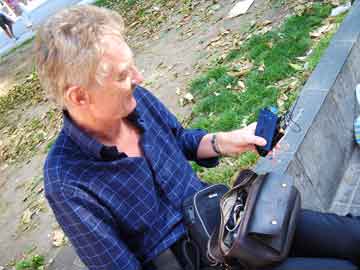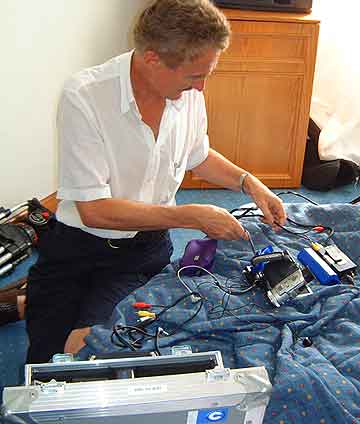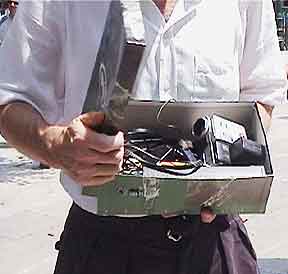 Over the years we minimized our equipment as we acquired smaller and smaller cameras of broadcast quality. With lighter equipment we became more maneuverable, better able to dash into subways, less reluctant to venture into deserted or potentially dangerous areas, and quicker on our feet. With hidden cameras and remote controls to operate them, we were later able to film con men like the bait-and-switch masters in Naples, and the pigeon poop duper in Barcelona. As we learned to recognize more sophisticated thieves, we were able to capture their deeds with more sophisticated devices.
Over the years we minimized our equipment as we acquired smaller and smaller cameras of broadcast quality. With lighter equipment we became more maneuverable, better able to dash into subways, less reluctant to venture into deserted or potentially dangerous areas, and quicker on our feet. With hidden cameras and remote controls to operate them, we were later able to film con men like the bait-and-switch masters in Naples, and the pigeon poop duper in Barcelona. As we learned to recognize more sophisticated thieves, we were able to capture their deeds with more sophisticated devices.
We trekked through Florence as we did Rome. Wherever the tourists flock there, the urchins prey: all around the wedding-cake-like Duomo, outside the Ufizi, on and near the Ponte Vecchio, and at the outdoor markets. Women with children even operate inside the dimly-lit cathedrals, where tourists least expect them. The child-thieves can be shockingly aggressive, blocking a person’s progress while working busily under their cardboard shields. They’re so accustomed to visitors with video cameras, they repeatedly dug into our pockets while we shot them at point blank range.
 At some point we began to carry a wallet stuffed with cut paper instead of money. That raggedy bait was stolen from our pockets by a hundred hands, with slow stealth, crude speed, cunning, or clumsiness. We almost always got it back just by asking. But we found the actual extraction of the wallet near impossible to film. The thieves got too close and covered their steals with a jacket, bag, or some other shield. We needed a creative solution.
At some point we began to carry a wallet stuffed with cut paper instead of money. That raggedy bait was stolen from our pockets by a hundred hands, with slow stealth, crude speed, cunning, or clumsiness. We almost always got it back just by asking. But we found the actual extraction of the wallet near impossible to film. The thieves got too close and covered their steals with a jacket, bag, or some other shield. We needed a creative solution.
After infinite ideas and frustrating failures, Bob had a brainstorm. He got an empty shoebox and filled it with sophisticated electronics. He fitted a pinhole lens onto one of his small cameras, and poked its miniature eye through the bottom of the shoebox. He made another hole for a tiny red diode which signified the camera’s record mode. Lastly, he connected a remote control to a short wire and let it protrude unobtrusively from the box, providing a means to start and stop the camera. With a brick-like battery and a tangle of wires completing the package, Bob’s ominous box would never make it through airport security.
 I snapped a few rubber bands over the lid and Bob tucked the box neatly under his arm, lens pointing down toward his pocket. That’s how the shoebox-cam was invented.
I snapped a few rubber bands over the lid and Bob tucked the box neatly under his arm, lens pointing down toward his pocket. That’s how the shoebox-cam was invented.
Thus rigged, we’d created a space not easily blocked by a thief, a void full of light which preserved the camera’s view of Bob’s pocket. The shoebox-cam proved useful in many situations and became one of our favorite capturing devices along with the cellphone-cam, eyeglass-cam, and button-cam.
Excerpt from Travel Advisory: How to Avoid Thefts, Cons, and Street Scams
Chapter One (part-k): High and Dry on the Streets of Elsewhere

